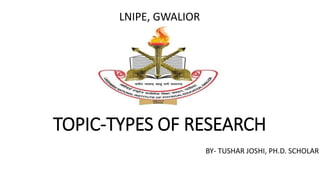
TYPES OF RESEARCH.pptx
- 1. TOPIC-TYPES OF RESEARCH LNIPE, GWALIOR BY- TUSHAR JOSHI, PH.D. SCHOLAR
- 2. WHAT IS RESEARCH Research is the careful consideration of study regarding a particular concern or problem using scientific methods. According to the American sociologist Earl Robert Babbie, “research is a systematic inquiry to describe, explain, predict, and control the observed phenomenon. It involves inductive and deductive methods.”
- 3. TYPES OF RESEARCH OR RESEARCH METHODOLOGY Research methodology refers to the methods and techniques used to portray the research effectively. It concerns the systematic design of a study to guarantee results that meet the aims and objectives of the study. The researcher is primarily responsible for presenting the idea and explaining different research methodology approaches.
- 4. RESEARCH METHODOLOGY CAN BE CATEGORIZED IN 5 GROUP- 1. GENERAL CATEGORY 2. NATURE OF STUDY 3. PURPOSE OF STUDY 4. DATA TYPE 5. RESEARCH DESIGN
- 5. GENERAL CATEGORY This category consists of- •QUANTITATIVE RESEARCH •QUALITATIVE RESEARCH
- 6. QUANTITATIVE RESEARCH As the name suggests, Quantitative data relies on quantifying a certain amount or quantity of a specific phenomenon. It focuses on gathering and analysing numerical data and can be used to find averages and patterns or to predict outcomes. It falls within the two primary categories of research and relies on numbers. It draws a conclusion using tables, facts, and graphs. Many scientific and field-based studies primarily use this form of research.
- 7. QUALITATIVE RESEARCH Qualitative refers to the non-numerical elements in the research. Qualitative research comes to the rescue when the researcher cannot grasp the information or data in terms of numbers. Though not as reliable as Quantitative research, qualitative research helps to form a better summary of theories in the data. Moreover, this type of research is interested in discovering the motivating factors behind human behavior, i.e., why people act or think in a particular way. Through this research, one can understand the variables driving people to behave in a certain way or which govern their inclinations towards one specific thing.
- 9. NATURE OF STUDY This category consists of- •DESCRIPTIVE RESEARCH •ANALYTICAL RESEARCH
- 10. DESCRIPTIVE RESEARCH Descriptive research is a type of analysis that outlines the features of the population or issues under study. This descriptive methodology focuses on the “what” of the research problem more than the “why.” Since the researcher cannot influence the variables in this research design, they can only report the facts precisely as they occurred or are occurring. The primary methods used in descriptive research include observations, surveys, and case studies. One can use many variables in descriptive research to explain the facts.
- 11. ANALYTICAL RESEARCH • Analytical research uses proven facts to form the basis for the research. Researchers frequently research to find supporting data that strengthens and authenticates their earlier findings. Also, it helps to develop new concepts related to the research subject. Thus, analytical research combines minute details to produce more tenable hypotheses. The analytical study thus explains why a claim is valid. • There are various ways to conduct this research, including meta-analysis, literary or scientific trials, and learning about public opinion.
- 12. PURPOSE OF STUDY This category consists of- •APPLIED RESEARCH •FUNDAMENTAL RESEARCH
- 13. APPLIED RESEARCH Action research that only studies one domain and usually generalizes the findings is called applied research. The researcher regards the variables as constant and the researcher forecasts, making the methods easy to find in applied research. Applied research aims to solve a current issue facing society or a business/industrial organization. Applied research is considered non-systematic inquiry; a business, government body, or individual typically conducts this research to address a particular issue.
- 14. FUNDAMENTAL RESEARCH The formulation of a theory and generalizations are the primary concerns of fundamental research. It seeks to discover facts with a wide range of applications, supplementing the ideas already known in a specific field or industry. Several domains are connected, and the aim is to discover how one can change traditional things or develop something new. One can find the summary in everyday language and apply logical findings in the research.
- 16. RESEARCH DESIGN This category consists of- •EXPLORATORY RESEARCH •CONCLUSIVE RESEARCH
- 17. EXPLORATORY RESEARCH Theories and their explanation are the basis of Exploratory Research. Its goal is only to investigate the study questions, not to provide definitive and conclusive solutions to current problems. Exploratory research seeks to increase our understanding of the issue rather than offering conclusive evidence. The structure is improper, and the methods offer a flexible and investigative approach. Therefore, one does not test the hypothesis, and the results do not help the outside world. The findings are usually a related topic, which helps improve the research.
- 18. CONCLUSIVE RESEARCH Conclusive research has a clear design in the methodology and intends to answer the research question. A well-thought-out structure helps formulate and solve the hypotheses and gives the results. The results are generic here. Furthermore, it is essential to establish this study’s research objectives and data requirements, as conclusive research findings typically have a specific purpose. The results of exploratory studies can be validated and quantified using a conclusive research design.
- 19. DATA TYPE This category consists of- •PRIMARY RESEARCH •SECONDARY RESEARCH
- 20. PRIMARY RESEARCH • The researchers gather new data for primary research. The research classifies as primary when the researcher collects information on a certain topic for the first time. Surveys, interviews, and observation are a few common ways of gathering data.
- 21. SECONDARY RESEARCH • Secondary research uses previously gathered data through primary research. Books, magazines, trade journals, and other media majorly serve as secondary data sources. Moreover, the researcher does not carry out primary data gathering in this case.